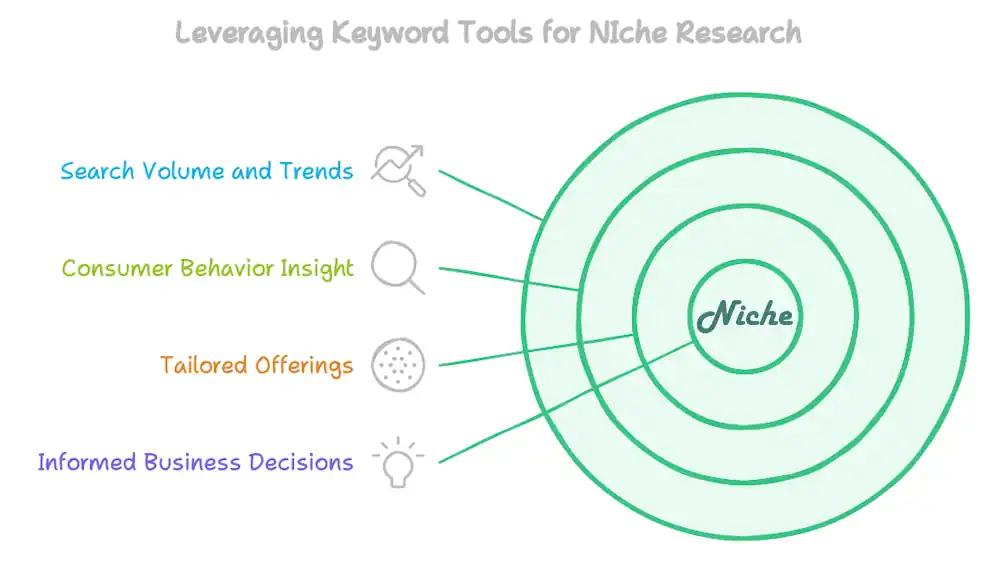If you want to succeed in niche marketing then you need to do a lot of research before you choose a niche. Making the wrong choice of niche can be a total disaster and can lead you to give up because you can’t make any money from it. So follow these steps to research a profitable niche market.

1. Keyword Research
Most online marketers either ignore keyword research or do it halfheartedly. This is a big mistake. Knowing what search terms your niche audience uses to find answers to their problems is very valuable and it is easy to find this out.
Use Keyword Tools
Using keyword tools is essential for identifying a profitable niche market, as they provide insights into search volume, trends, and competition levels for specific keywords. By analyzing this data, you can uncover underserved areas where demand exceeds supply, allowing you to tailor your offerings effectively. Additionally, these tools can help you understand consumer behavior and preferences, enabling you to create targeted content that resonates with your audience. Ultimately, leveraging keyword research can lead to more informed business decisions and increased chances of success in a competitive landscape.
Let’s take the example of the health and wellness niche, specifically focusing on “plant-based diets.”
Using Keyword Tools: Using tools like Google Keyword Planner or SEMrush, you can input “plant-based diet” to analyze various related keywords. You might find keywords such as “plant-based meal plans,” “benefits of plant-based diets,” and “easy plant-based recipes.”
Search Volume and Trends: Upon exploring these keywords, you notice that “easy plant-based recipes” has a high search volume but relatively low competition. This indicates strong demand with fewer resources available, suggesting a potential niche.
Consumer Behavior Insight: Further analysis might reveal that users searching for “easy plant-based recipes” frequently seek quick, healthy options that fit into a busy lifestyle. This insight can inform your content creation strategy.
Tailoring Offerings: With this understanding, you could develop a targeted blog or YouTube channel focusing on quick, easy-to-follow plant-based recipes. You might also consider creating an e-book or meal prep service that caters specifically to busy individuals looking to adopt a plant-based lifestyle.
Informed Business Decisions: By leveraging keyword research, you can effectively position your brand within this niche, aligning your offerings with clear consumer demands. This strategic approach increases your chances of success amidst the competitive health and wellness market.
By using keyword tools to identify underserved areas and understanding consumer preferences, you can create targeted, valuable content that resonates with your audience and enhances your business prospects.

Analyze Search Volume
Using keyword tools to analyze search volume is essential for identifying profitable niche markets. By examining the search volume of specific keywords, you can gauge the level of interest and demand within a particular market segment.
For example, if you find that “eco-friendly home products” has a high search volume but low competition, it could indicate a lucrative niche worth exploring for a business focused on sustainable living. Such insights can guide your content strategy and product development, ensuring you target areas with potential customer interest.
Identify Long-Tail Keywords
Using keyword tools to identify long-tail keywords can significantly enhance your ability to choose a profitable niche market. Long-tail keywords typically have lower competition and higher conversion rates, making them ideal for targeting specific audiences.
For example, instead of targeting a broad keyword like “running shoes,” you might discover a long-tail keyword such as “best running shoes for flat feet.” This more specific keyword not only indicates a particular audience’s needs but also helps you create tailored content or products that cater directly to that niche, ultimately increasing your chances of success in the market.
Google’s Free Keyword Planner
By using the free Google Keyword Planner you can find lots of keywords related to your niche and also the estimated search volumes which is a good indication of the size of the niche market.
It is really easy to use the Google Keyword Planner. All you need to do is to enter a seed keyword and then you will automatically receive other related keywords for the niche. You will also discover the average cost per click for PPC advertising using Google Adwords and the competition for ads around individual keywords.
You can export lists of keywords very easily with the Google Keyword Planner and create a master spreadsheet with all of the keywords in it. Then you can go through them all and decide which ones to use.
2. Know the Niche Audience
If you are interested in a particular niche idea then find out as much as you can about the audience. You want to know what problems they are having and what interests them the most. It is all about understanding their needs as much as possible.
Demographic Analysis
Understanding the demographic profile of your target audience is crucial for identifying a niche market. This includes factors such as age, gender, income level, education, and geographic location. By analyzing these characteristics, you can tailor your marketing strategies and product offerings to meet the specific preferences and behaviors of your audience.
For example, let’s say you’re launching a new line of eco-friendly kitchen products. After conducting demographic research, you discover that your target audience primarily consists of:
Age: 25-40 years old
Gender: Predominantly female
Income Level: Middle to upper-middle class, with disposable income for sustainable products
Education: College-educated, with a strong awareness of environmental issues
Geographic Location: Urban areas in eco-conscious cities like San Francisco, Portland, and Seattle
With this demographic profile in mind, you can tailor your marketing strategies by focusing on social media platforms popular with this age group, such as Instagram and Pinterest. You might emphasize the sustainability and health benefits of your products in your messaging, and consider partnerships with eco-friendly influencers who resonate with this audience. Additionally, you could host pop-up events in these urban areas to create a community around your brand and engage directly with potential customers.
Psychographic Analysis
Beyond demographics, psychographic analysis delves into the values, interests, lifestyles, and personalities of your target market. This approach helps you understand what motivates your audience, allowing you to create more resonant messaging and branding. By tapping into the emotional and psychological drivers of your niche, you can foster stronger connections and brand loyalty.

For example, consider a brand that sells eco-friendly skincare products. While demographic data might reveal that their target audience is primarily women aged 25-40, psychographic analysis could uncover deeper insights. This audience values sustainability, is passionate about environmental issues, and leads a healthy lifestyle. They are likely to be involved in community activism and prefer brands that align with their ethical beliefs.
By understanding these psychographics, the brand can craft messaging that emphasizes their commitment to sustainability and the natural ingredients used in their products. Campaigns might highlight stories of environmental impact, feature testimonials from customers who value eco-conscious choices, and showcase community initiatives they support. This approach not only resonates emotionally with the target audience but also fosters brand loyalty by aligning with their values and lifestyle.
Customer Needs
Identifying customer needs is fundamental to successfully targeting a niche market. This involves understanding the specific problems or desires that your audience faces and how your product or service can address them. Conducting surveys, interviews, and market research can provide insights into these needs, enabling you to develop solutions that are not only relevant but also compelling to your niche audience.
Let’s say you’re looking to target a niche market of eco-conscious consumers interested in sustainable home products. To identify their specific needs, you could conduct surveys and interviews to understand their concerns about environmental impact, product sourcing, and quality.
Through this research, you might discover that many consumers want eco-friendly cleaning products that are both effective and safe for their families and pets. They may also express a desire for refillable packaging to reduce waste.
Armed with this information, you could then develop a line of biodegradable cleaning products that come in reusable containers, along with a subscription service that allows customers to receive refills conveniently. This tailored solution addresses both the desire for sustainability and the practical need for effective cleaning, making it compelling for your niche audience.
When you know your audience well you have a lot more chance of succeeding with the niche. You can publish content that will resonate with them and make offers for products and services that will solve their problems.
3. How Competitive is the Niche?
You need to determine how competitive the niche is that you are considering. Whether you will drive traffic using paid ads, SEO, or social media (or a combination of them all) it is important that you know what you are up against.
But don’t let anyone tell you that you don’t want any competition. If there is no competition in a niche, it’s likely because there’s little interest or little profit in that niche.
The Google Keyword Planner will tell you the ad competition for Google Adwords and the average cost per click. Analyzing how difficult it will be to rank in the search engines for specific keywords is not so easy but there are services and tools available to help you with this.
Competitor Analysis
When choosing a niche market, conducting a thorough competitor analysis is essential. This involves identifying key players within the market, understanding their strengths and weaknesses, and evaluating their marketing strategies. By analyzing competitors, you can uncover gaps in the market that your business can exploit and create a strategy that differentiates your offerings.
Market Saturation
Market saturation refers to the level at which a niche is filled with competing products or services. You’ll want to assess whether the market is oversaturated, as entering a crowded niche can make it challenging to gain traction. Identifying a niche that is either emerging or underrepresented can provide opportunities for growth and profitability.

Unique Selling Proposition
A strong unique selling proposition (USP) sets your business apart from competitors within your chosen niche market. Your USP should clearly articulate what makes your product or service distinct and why customers should choose you over others. By defining a compelling USP, you can effectively attract and retain customers, ensuring that your business stands out in a competitive landscape.
4. Look at Trends
Using a tool like Google Trends will tell you whether there is steady demand for a specific keyword or whether there are extreme peaks and troughs. Some niches do very well during the holiday season, but not as well the rest of the year. Other niches might do well in warm weather, but not during the winter months. Ideally, you want a niche that does well year-round. Trends will also show you if the demand is going up or tapering off.
Market Trends
Understanding current market trends is essential for identifying niche opportunities. Analyzing consumer behavior, purchasing patterns, and demographic shifts can reveal gaps in the market that a niche offering could fill. For instance, the growing interest in sustainability and eco-friendly products has led to the emergence of numerous niches focused on green living.
Seasonal Trends
Seasonal trends play a crucial role in niche market selection, as they can significantly influence consumer demand. By recognizing seasonal fluctuations—such as holiday shopping, summer travel, or back-to-school preparations—entrepreneurs can tailor their products and marketing strategies to align with peak demand periods. For example, niche markets related to holiday-themed goods often see a surge in sales during the months leading up to major holidays.
If you decide to venture into a seasonal niche like selling snow blowers, it’s important to have a strategy in place for the off-season, such as the summer months. During this time, sales can plummet, so entrepreneurs should consider diversifying their offerings or pivoting their marketing approach.
One strategy might be to expand the product line to include complementary items that are relevant in warmer months, such as lawn care equipment, outdoor furniture, or gardening tools. This allows you to maintain customer engagement and revenue streams throughout the year.
Additionally, you could focus on marketing campaigns that emphasize maintenance and preparation for the upcoming winter season. Offering discounts on off-season purchases or promoting early-bird specials can incentivize customers to buy snow blowers ahead of the winter rush.
Engaging with your audience through content marketing—such as blogs or videos on winter preparation tips—can help keep your brand top-of-mind, while also providing valuable information that builds trust and authority in your niche. By planning for the off-season, you can mitigate the challenges of seasonal fluctuations and maintain a steady flow of income year-round.
Emerging Technologies
The rapid advancement of emerging technologies can create new niche markets that cater to tech-savvy consumers. Innovations such as artificial intelligence, virtual reality, and blockchain are opening doors for specialized products and services, from smart home devices to personalized online experiences.
Keeping an eye on these technologies can help entrepreneurs identify untapped niches that leverage the latest advancements, thus positioning them ahead of the competition. Exploding Topics is an amazing place to find under-the-radar industries, products, and categories that are trending now.
Social Media: There are other ways to look at trends too. With most social media platforms you can see the trends for keywords or “hashtags” and again you will discover if there are upward or downward trends. This is definitely worth doing when you are considering a niche idea.
5. Is the Niche right for you?
This is not a method of research but it is still important. Do you feel comfortable operating in a specific niche? Is it something that you can be interested in and even passionate about? Or would you feel lost when trying to add content for the niche? If the idea of entering a niche leads to negative thoughts about it then move on to another niche idea.
Personal Interests
Selecting a niche that aligns with your personal interests can be important for maintaining motivation and enthusiasm over time. When you’re genuinely passionate about a subject, it’s easier to create content, engage with your audience, and stay committed even during challenging times. Reflect on what topics excite you and how they can be integrated into your niche.
While many experts emphasize the importance of choosing a niche that aligns with your personal interests, it’s worth noting that not everyone agrees on this point. Some argue that focusing solely on market demand and profitability can be more advantageous than personal passion. They believe that a successful niche can be built on research, trends, and audience needs, even if the content creator does not have a deep personal connection to the subject. This perspective suggests that a more analytical approach can lead to a sustainable business model, as long as the creator is willing to invest the time and effort to understand and engage with the topic. Ultimately, the choice between passion and practicality may depend on individual preferences and goals, and striking a balance between the two can often yield the best results.
Skills and Expertise
Your existing skills and expertise can significantly influence your success in a niche. Assess what knowledge or talents you possess that can add value to your chosen area, as this can help establish credibility and build trust with your audience. Leveraging your strengths not only enhances your content but also allows you to stand out in a competitive market.
Long-Term Viability
Consider the long-term viability of your niche by evaluating trends, market demand, and potential for growth. A sustainable niche should have a consistent audience and the ability to adapt to changes over time. Researching industry forecasts and consumer behavior can help ensure that your chosen niche remains relevant and profitable in the future.

By following these strategies, individuals can effectively pinpoint lucrative niche opportunities, increasing their chances of success in the marketplace.


